
Recently, the research team led by Prof. Ying Guangguo at South China Normal University's School of Environment, including Dr. Liu Yousheng and Associate Researcher Peng Fengjiao, published a study titled "Removal of emerging organic contaminants in a subsurface wastewater infiltration system: A preliminary study of microbial mechanism" in the renowned journal Water Research (DOI: 10.1016/j.watres.2025.123960). The study investigated the removal efficiency of emerging organic contaminants (EOCs) in real domestic wastewater by subsurface wastewater infiltration systems (SWIS) and elucidated the underlying microbial mechanisms.
The researchers constructed a multi-layer media SWIS with intermittent aeration. After the system reached steady-state operation, comprehensive analyses were performed on EOCs, conventional pollutants, bacterial communities, and functional microbial populations in both influent/effluent and filter media. Results showed that 17 out of 89 target EOCs were detected in the influent, with removal rates exceeding 74.5% for most compounds. Furthermore, significant positive correlations were identified between pollutant removal efficiency and the abundance of specific microbial taxa, confirming biodegradation as the dominant EOC removal mechanism in SWIS. These findings provide critical scientific support for implementing SWIS in rural domestic wastewater treatment.
Highlights
To address knowledge gaps regarding EOC removal efficiency and mechanisms in SWIS treating decentralized domestic wastewater, this pilot-scale field study examined pollutant removal characteristics and microbial-driven processes in an intermittently aerated SWIS under a hydraulic loading rate of 0.5 m³/(m²·d).
Seventeen EOCs were detected in the influent, including biocides (7), antibiotics (5), pharmaceuticals (2), and herbicides (3). Remarkably, 15 EOCs achieved removal rates >74.5%, except for DEET (31.9%) and sulfamonomethoxine (58.8%), while conventional pollutants (COD, NH₄⁺-N, etc.) were removed at >81% efficiency. Statistical analyses revealed significant positive correlations between pollutant removal and key microbial phyla/genera (Proteobacteria, Planctomycetes, Bacteroidetes, Rhodanobacter, Ottowia). This study demonstrates SWIS's effectiveness in removing diverse EOCs via microbially dominated pathways, offering technical insights for decentralized wastewater treatment in rural areas while highlighting microorganisms' pivotal role.
Introduction
Global wastewater production has reached 359.4 billion m³ annually, yet treatment rates remain critically low: just 43%, 26%, and 4.2% in high-middle, low-middle, and low-income countries respectively. This urgent situation demands cost-effective, energy-efficient, and easy-to-operate technologies like subsurface wastewater infiltration systems (SWIS). Although SWIS has been widely adopted for decentralized rural wastewater treatment, systematic understanding of its efficiency and mechanisms for emerging organic contaminant (EOC) removal remains limited.
To bridge this gap, we developed a multi-layer media SWIS operating at 0.5 m³/(m²·d) hydraulic loading with intermittent aeration. Our results conclusively demonstrate the system's high EOC removal performance in real domestic wastewater through microbial degradation pathways.
Graphical Abstract Guide
System Configuration
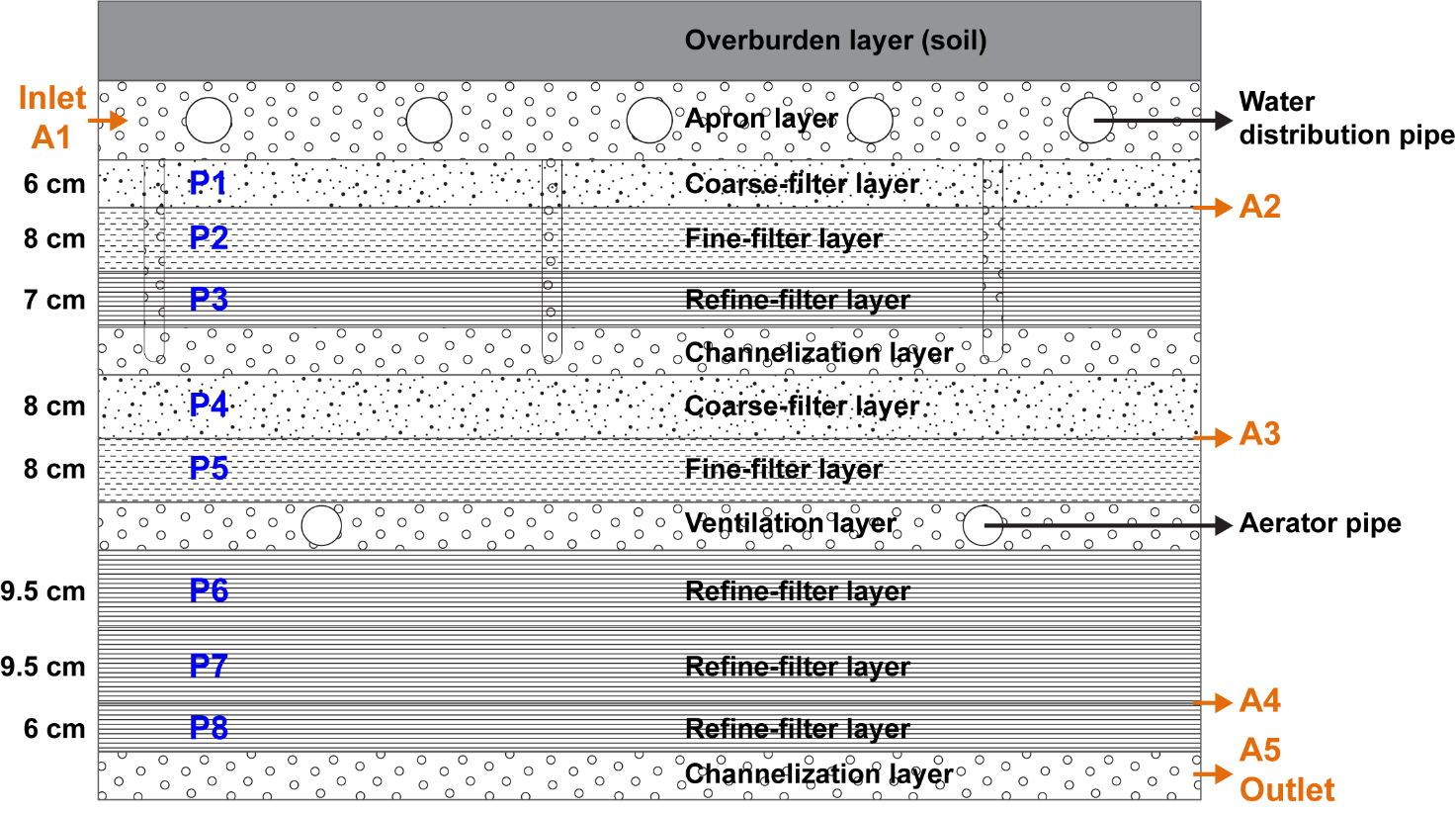
Fig. 1. Schematic diagram of the pilot-scale subsurface wastewater infiltration system (SWIS).
This study constructed a subsurface wastewater infiltration system (SWIS) using a leak-proof concrete tank (L×W×H: 1.0 m × 1.0 m × 1.0 m). The system featured a total media height of 1.0 m, comprising eight sand-based functional layers of varying particle sizes (labeled P1-P8 top-to-bottom) and five auxiliary structural layers. A water distribution pipe and aeration pipe were installed in the influent distribution and aeration layers, respectively, with effluent sampling ports positioned at the base of layers P1, P4, P7, and P8. To isolate microbial processes as the dominant removal mechanism, the SWIS was designed as a plant-free configuration, thereby eliminating interference from plant uptake and root exudates.
Overall Removal Efficiency
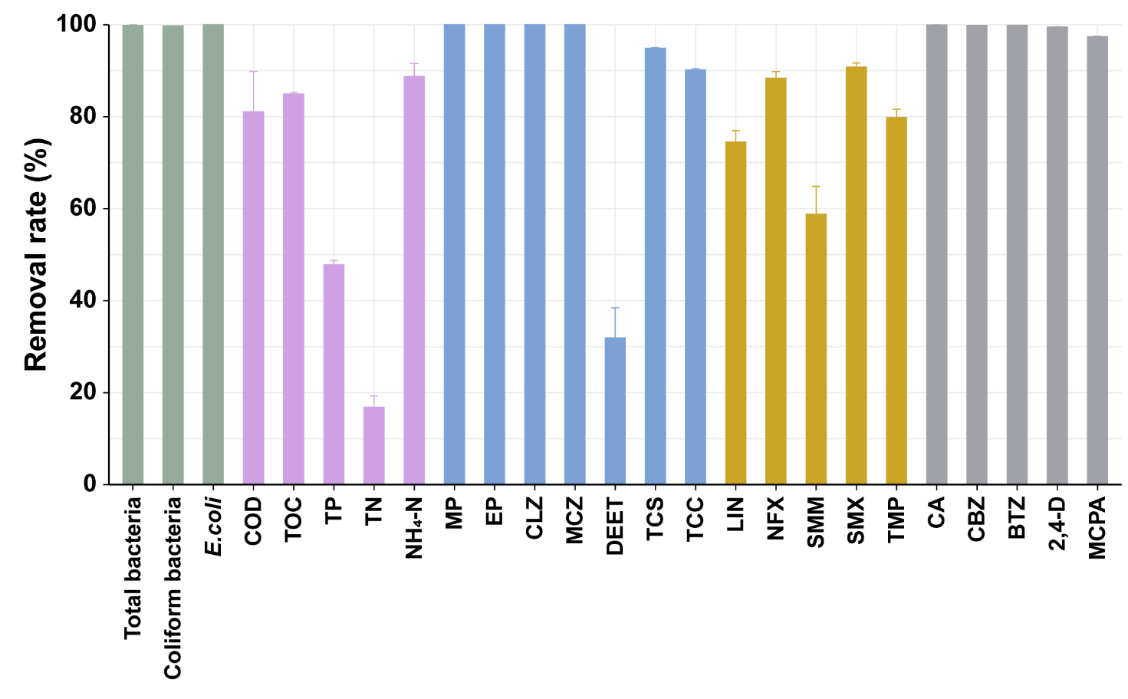
Fig. 2. Removal rates (%) of bacteria (green bars), conventional pollutants (pink bars), and detected biocides (blue bars), antibiotics (yellow bars) and other compounds (grey bars) in SWIS.
Pollutant removal analysis demonstrated significant efficacy of the constructed SWIS in treating both conventional pollutants and emerging organic contaminants (EOCs) from real domestic wastewater. Removal rates exhibited spatial heterogeneity across functional layers, with the lowest efficiency observed in the bottom layer.
Removal rates of each functional layer
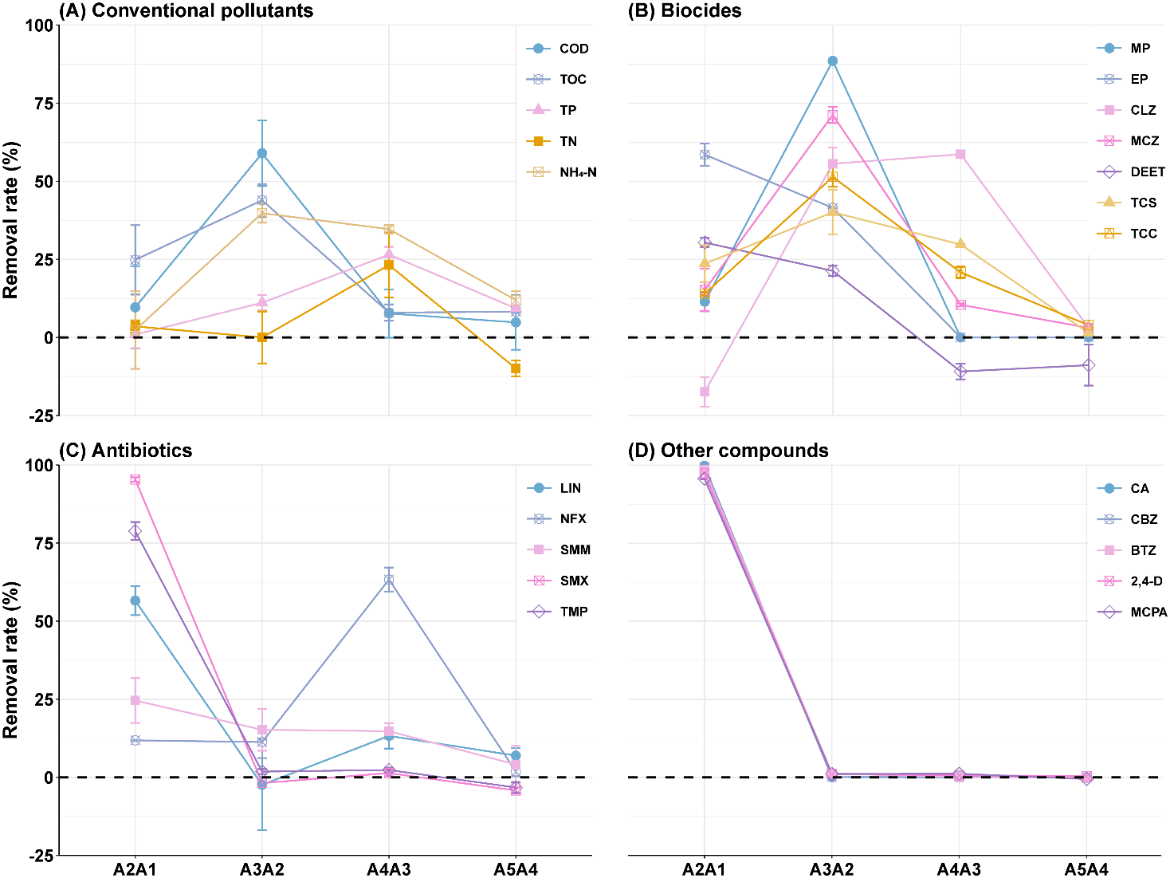
Fig. 3. Removal rates (%) of conventional pollutants (A) and detected biocides (B), antibiotics (C) and other compounds (D) across different packing layers in the subsurface wastewater infiltration system (SWIS).
The removal rates of conventional pollutants and EOCs in each functional layer of SWIS show spatial differences, among which the removal efficiency of the bottom layer is the lowest.
Dominant Microbial Communities in SWIS Media
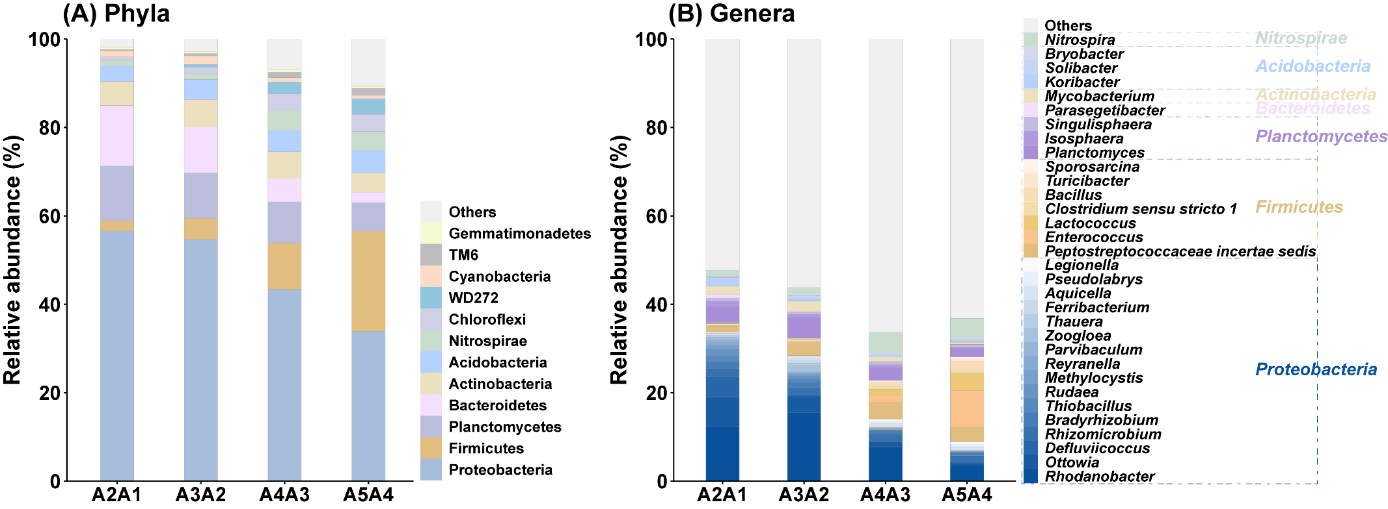
Fig. 4. Relative abundances (%) of phyla (A) and genera (B) in the substrate of the subsurface wastewater infiltration system (SWIS).
Microbial community analysis revealed 12 phyla and 32 genera with relative abundances ≥0.5% in the SWIS media layers. Proteobacteria emerged as the dominant phylum across all layers, while Rhodanobacter was the predominant genus in layers A2A1 and A3A2.
Univariate Correlations Between Pollutant Removal and Microorganisms
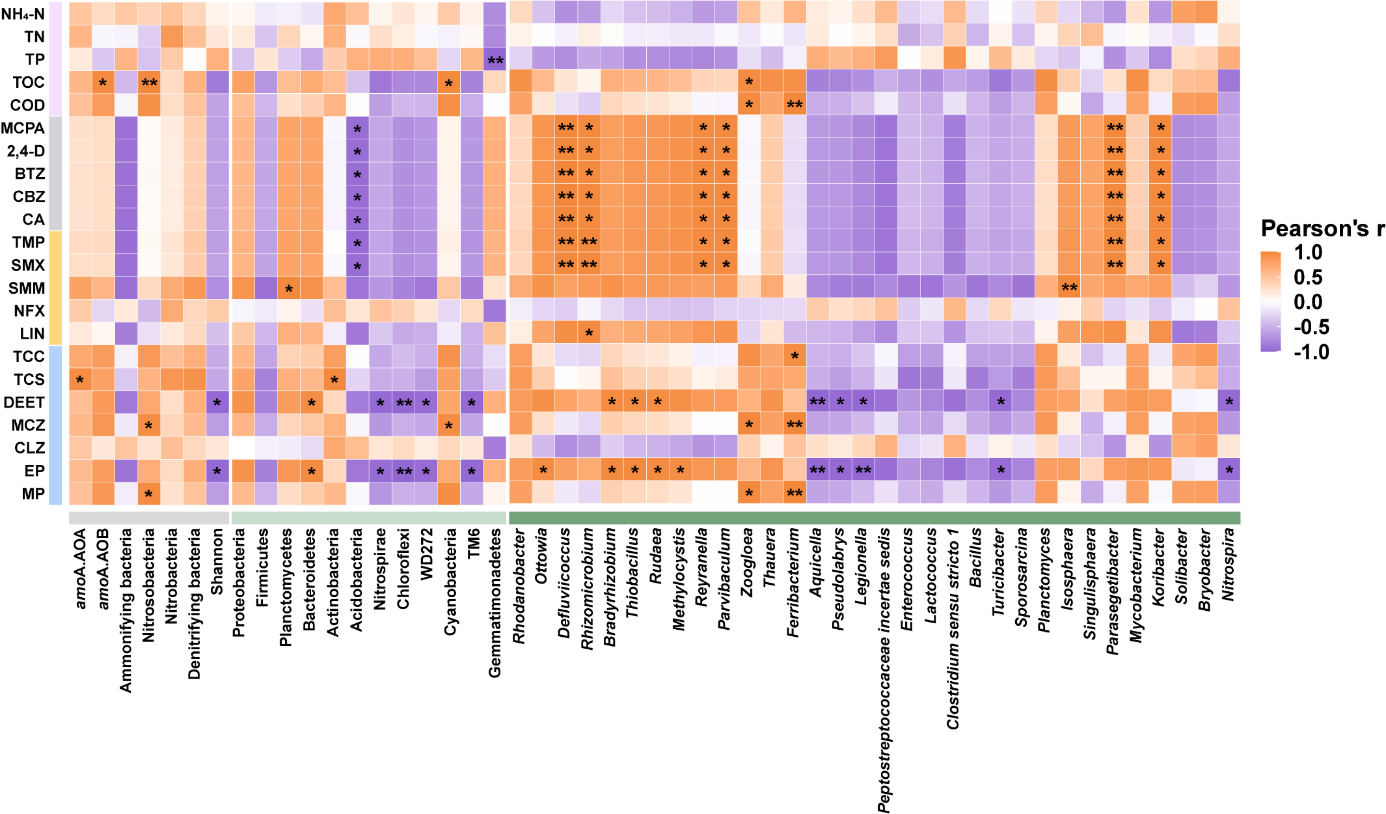
Fig. 5. Heatmap showing Pearson correlations between pollutant removal rates and microbial data across different packing layers in the SWIS.
Pearson correlation analysis demonstrated significant relationships between removal efficiencies of conventional pollutants and specific microbial taxa:
・COD, TOC, and TP removal: Correlated with Zoogloea, Ferribacterium, Cyanobacteria, Gemmatimonadetes, and nitrite-oxidizing bacteria.
・Biocide removal (methylparaben, ethylparaben, DEET, miconazole, triclosan, triclocarban): Showed significant/marginally significant correlations with Zoogloea, Ferribacterium, Bradyrhizobium, Thiobacillus, Proteobacteria, Bacteroidetes, Actinobacteria, nitrite-oxidizing bacteria, and ammonifying bacteria.
・Antibiotics/other EOCs removal: Associated with Bradyrhizobium, Ottowia, Defluviicoccus, ammonifying bacteria, Planctomycetes, Bacteroidetes, Firmicutes, and Acidobacteria.
Multivariate Associations Between Pollutant Removal and Microorganisms
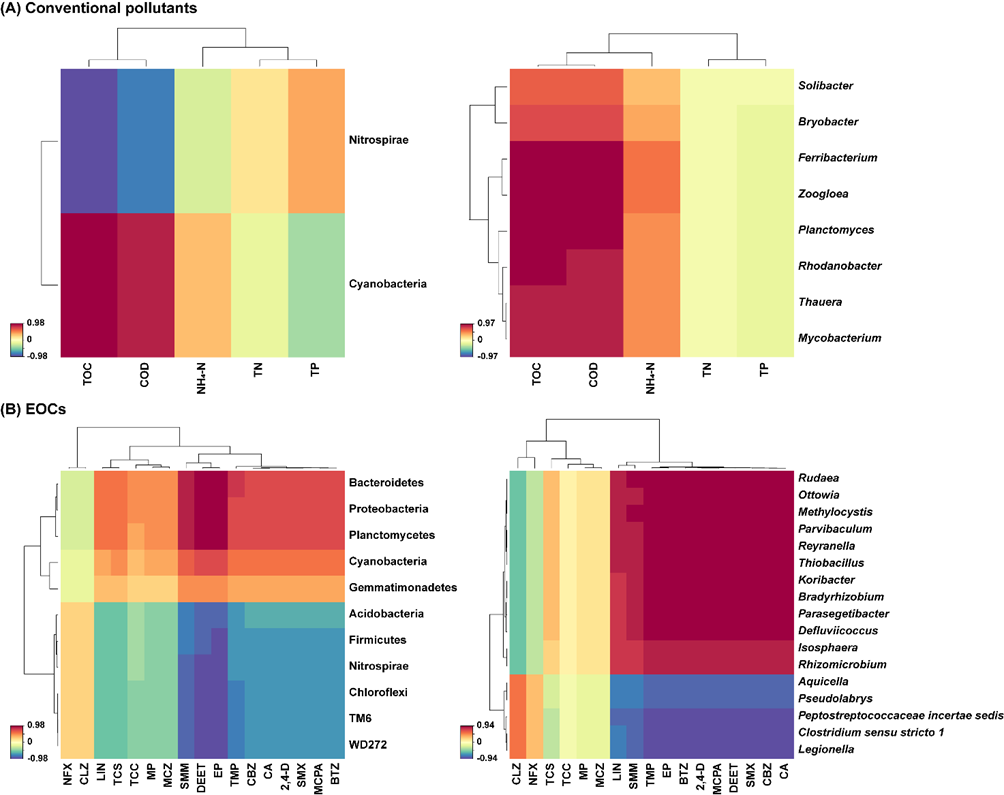
Fig. 6. Clustered image maps from the sparse partial least squares (sPLS) models inducing sparsity on explanatory variables (phyla with a relative abundance ≥ 0.5%, left; genera with a relative abundance ≥ 0.5%, right) for the removal rates of conventional pollutants (A) and emerging organic contaminants (EOCs; B) in SWIS.
Sparse partial least squares (sPLS) regression analysis identified key microbial predictors:
・Conventional pollutant removal: Linked to Zoogloea, Ferribacterium, Rhodanobacter, Thauera, Planctomyces, Mycobacterium, amoA gene of ammonia-oxidizing bacteria (AOB), nitrite-oxidizing bacteria, Nitrospirae, and Cyanobacteria.
・EOC removal: Correlated with Ottowia, Defluviicoccus, ammonifying bacteria, Proteobacteria, and Firmicutes.
Summary
This exploratory study systematically reveals—for the first time—the efficiency and microbial-driven mechanisms of an intermittently aerated SWIS operating at 0.5 m³/(m²·d) hydraulic loading for removing emerging organic contaminants (EOCs) from real domestic wastewater. The findings provide a scientific foundation for implementing SWIS in rural wastewater management. Future research should address the impacts of environmental fluctuations and influent quality variations on system performance to enhance practical applicability and operational stability.
Full text available at
Peng, F.-J.; Feng, X.-J.; Li, S.; Yu, X.-L.; Chen, J.; Liu, S.-S.; Ying, G.-G.; Liu, Y.-S., Removal of emerging organic contaminants in a subsurface wastewater infiltration system: A preliminary study of microbial mechanism. Water Research 2025, 284, 123960. https://www.sciencedirect.com/science/article/pii/S0043135425008681